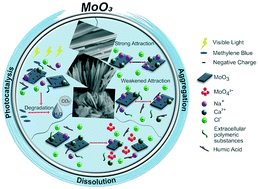Inorganic salts and organic matter effects on nanorod, nanowire, and nanoplate MoO3 aggregation, dissolution, and photocatalysis
Abstract
Use of visible light photocatalytic nanomaterials in water treatment can be promising in treating contaminants. However, little research has been conducted examining the effects of more complex chemistries in the nanomaterial's performance. In this work, the effects of inorganic salts (NaCl and CaCl2) and natural organic matter (NOM) such as humic acid (HA) and extracellular polymeric substances (EPS) on nanoparticle aggregation, dissolution, and ultimately on the photocatalytic properties of molybdenum trioxide (MoO3), i.e. nanorods, nanowires, and nanoplates were examined. In the presence of NaCl, nanorod, nanowire, and nanoplate MoO3 had similar critical coagulation concentrations, while the nanorods showed higher instability in CaCl2. Overall, the presence of inorganic salts caused high colloidal instability in the MoO3 nanostructures in terms of aggregation behavior, but greatly aided in the reduction of MoO3 dissolution. NOM presence decreased aggregation rates, albeit dissolution was not similarly affected in all three structures. Only the dissolution of the nanowire structures was reduced in the presence of HA or EPS. Furthermore, the photocatalytic activity of the nanowires and nanoplates was overall reduced when inorganic salts or natural organic matter were present. While the presence of natural organic matter alone did reduce photocatalytic effectiveness of the nanorod MoO3, the presence of salts seemed to negate the effects from the organic compounds. Furthermore, the presence of CaCl2 resulted in a highly enhanced photocatalytic activity regardless of the presence of natural organic matter. The structural and chemical differences of the nanomaterials played a significant role in their aggregation, dissolution, and ability to photocatalytically degrade methylene blue in solution. This study demonstrates that a better understanding of water chemistry effects on nanomaterials is essential prior to their intended applications.

- This article is part of the themed collection: Best Papers 2020 – Environmental Science: Nano


 Please wait while we load your content...
Please wait while we load your content...
